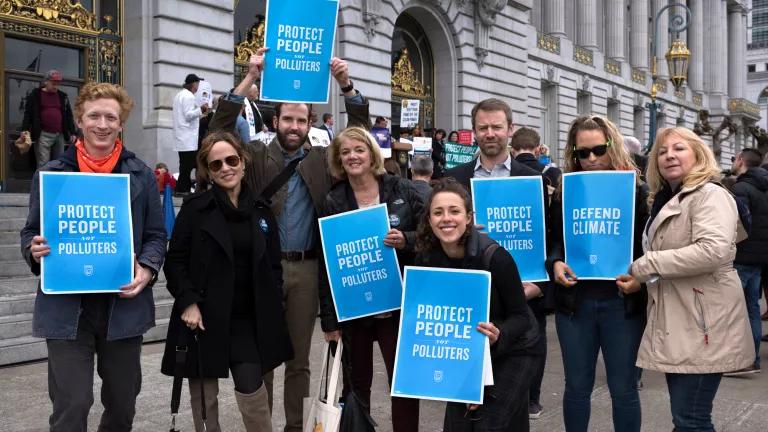Colorado and Virginia Shift from Super-Polluting HFCs

Two more states have joined the movement to shift away from hydrofluorocarbons (HFCs), the powerful climate pollutants used as refrigerants, foam-blowing agents and aerosol propellants. Colorado’s Air Quality Control Commission today approved prohibitions on a list of products containing HFCs (seen here as proposed). And yesterday Virginia Gov. Ralph Northam signed a new law requiring his state’s Air Pollution Control Board to adopt similar HFC restrictions.
This week’s developments bring to 16 the number of states taking action on HFCs by enacting new legislation or adopting new regulations under existing law. The others are California, Connecticut, Delaware, Hawaii, Maine, Maryland, Massachusetts, New Jersey, New York, Oregon, Pennsylvania, Rhode Island, Washington, and Vermont. (See here for background.)
The states are placing prohibitions on a set of HFC-containing products and equipment, allowing a reasonable transition schedule for adopting climate-friendly alternatives.
The rules being rolled out are consistent state to state, encouraging industry to offer the same products nationwide. Regulated sectors include commercial refrigeration, insulating foams, building chillers and aerosol products, among others.
Lack of clear federal guidance leads states to act
States are acting to fill a federal policy void. Since the late 1980s, the production and use of HFCs and their ozone-depleting predecessors, chlorofluorocarbons (CFCs), has been governed by federal EPA rules under the Clean Air Act. EPA rolled out two HFC rules under its Significant New Alternatives Policy (SNAP) program in 2015 and 2016. The SNAP program’s orderly schedule allowed adequate time for the industry to adapt and the rules enjoyed support from equipment manufacturers, chemical producers and the environmental community at large.
But federal progress was set back by litigation over EPA’s authority. Since 2017, the D.C. Circuit Court of Appeals has issued three decisions that, while upholding parts of EPA’s SNAP program, shielded product manufacturers who currently use HFCs from requirements to adopt climate-friendlier alternatives that are already on the market. (See here for a litigation update.)
Seeing the high costs of inaction, states are stepping in under their own pollution control authority. They are acting to fill the gap in federal regulation that is creating uncertainty in the U.S. market, penalizing the companies at the forefront of innovation, and giving up an opportunity for low-cost greenhouse gas emissions reductions across the country.
The 16 states acting on HFCs are members of the U.S. Climate Alliance, a bipartisan coalition of governors aiming to reduce greenhouse gas emissions. Once they complete adoption of the HFC restrictions, their rules will cover a market representing more than 35 percent of the U.S. population. This is already leveraging broader results, because most companies are planning to make their entire national product line to the same standards.
Federal policy is on the table once again
Bipartisan federal HFC legislation is under consideration in both chambers of Congress. This federal legislation provides a clear framework for a nationwide HFC production phase-down over the next 15 years, and it restores federal power to address end uses that can quickly switch to safe alternatives (more here).
The federal bill has broad bipartisan support and has been endorsed by a wide range of groups running from NRDC to the U.S. Chamber of Commerce.
The Senate Environment and Public Works Committee recently held a socially-distanced “hearing” on the Senate bill (S.2754), which has 34 cosponsors, 17 from each party. The House version (H.R. 5544) has been approved by a subcommittee of the House Energy and Commerce Committee and has 28 cosponsors, 14 from each party.
Despite the breadth of bipartisan support, there are obstacles. The senior Republicans on the two committees (Sen. John Barrasso (R-WY) and Rep. Greg Walden (R-OR)) have floated proposals to preempt state action. This would break from long-standing practice under our environmental laws, where EPA sets a federal floor and states are free to do more under their own laws. That includes the Clean Air Act’s provisions for phasing out ozone-depleting substances, on which the HFC bills are based.
Notably, the main industry supporters of the federal legislation have pushed back, recognizing that preemption proposals are both divisive and unnecessary. For example, the Air Conditioning, Heating, and Refrigeration Institute said:
[O]ur priority as an industry is not to do away with state standards—it is to fill the federal void with a competent, common sense federal standard, which we believe the AIM Act represents. Once that void is filled,…we do not believe state standards will pose a problem, particularly given that once a company has transitioned from HFCs, there is nothing further for a state to regulate.
If the federal bills become law, states will likely see less need for regulating HFCs. But it is important that states be there to fill the gap if the federal government should falter again.
So, hats off to leaders in Colorado and Virginia. The HFC action club continues to grow.





